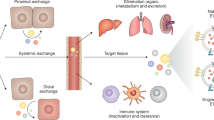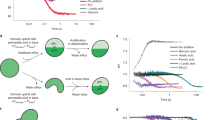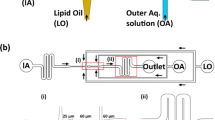Abstract
PHOSPHOLIPID vesicles (liposomes1) have been used extensively as models for natural membranes1,2. Multilamellar vesicles are incorporated by mammalian cells both in vivo3,4 and in vitro5. Sonication of such vesicles creates small (250–500 Å diameter) closed spherical vesicles composed of a single lipid bilayer enclosing an aqueous space2. Cultured mammalian cells will also incorporate these unilamellar vesicles without cytotoxic effects6. We present here data on the uptake of unilamellar vesicles by cells in vitro and the use of these vesicles as carriers to introduce biologically-active molecules into specific regions of the cell.
This is a preview of subscription content, access via your institution
Access options
Subscribe to this journal
Receive 51 print issues and online access
$199.00 per year
only $3.90 per issue
Buy this article
- Purchase on Springer Link
- Instant access to full article PDF
Prices may be subject to local taxes which are calculated during checkout
Similar content being viewed by others
References
Bangham, A. D., Ann. Rev. Biochem., 41, 753 (1972).
Papahadjopoulos, D., and Kimelberg, H. K., Prog. Surface Sci., 4, 141 (1973).
Gregoriadis, G., FEBS Lett., 36, 292 (1973).
Rahman, Y. -E., Rosenthal, M. W., and Cerny, E. A., Science, 180, 300 (1973).
Gregoriadis, G., and Buckland, G. A., Nature, 244, 170 (1973).
Papahadjopoulos, D., Poste, G., and Mayhew, E., Biochim. biophys. Acta, 363, 404 (1974).
Papahadjopoulos, D., Poste, G., and Schaeffer, B. E., Biochim. biophys. Acta, 323, 23 (1973).
Jung, C. Y., Carlson, L. M., and Baher, C. J., Biochim. biophys. Acta, 298, 101 (1973).
Mayhew, E., and Juliano, R., Expl Cell Res., 77, 409 (1973).
Ehnholm, C., and Zilversmit, D. B., J. biol. Chem., 248, 1719 (1973).
Kamath, S. A., and Rubin, E., Arch. biochem. Biophys., 158, 312 (1973).
Ryser, H. J. P., in Biomembranes (edit. Manson, L.), 2, 197 (Plenum, New York,, 1971).
Sheppard, J. R., in Membranes and viruses in immunopathology (edit. Day, S. B., and Good, R. A.), 249, (Academic Press, New York, 1972).
Papahadjopoulos, D., Poste, G., Schaeffer, B. E., and Vail, W. J., Biochim. biophys. Acta, 352, 10 (1974).
Tappel, A. L., in Lysosomes in biology and pathology (edit. Dingle, J. T., and Fell, H. B.), 2, 207 (North Holland, Amsterdam, 1969).
Inbar, M., and Shinitzky, M., Proc. natn. Acad. Sci. U.S.A., 71, 2128 (1974).
Vail, W. J., Papahadjopoulos, D., and Moscarello, M., Biochim. biophys. Acta, 345, 463 (1974).
Pagano, R. E., Huang, L., and Wey, C., Nature, 252, 166–167 (1974).
Author information
Authors and Affiliations
Rights and permissions
About this article
Cite this article
PAPAHADJOPOULOS, D., MAYHEW, E., POSTE, G. et al. Incorporation of lipid vesicles by mammalian cells provides a potential method for modifying cell behaviour. Nature 252, 163–166 (1974). https://doi.org/10.1038/252163a0
Received:
Revised:
Issue Date:
DOI: https://doi.org/10.1038/252163a0
This article is cited by
-
Incorporation of small unilamellar liposomes loaded with horseradish peroxidase into isolated nerve endings from electric organ ofTorpedo marmorata
Journal of Neurocytology (1983)
-
Incorporation of the antitumor alkaloid thaliblastine in liposomes enhances its cytotoxic activity in vitro
Experientia (1982)
-
Uptake of free and liposome-entrapped125I-labelled PVP by rat intestinal sacs in vitro: evidence for endocytosis
Bioscience Reports (1981)
Comments
By submitting a comment you agree to abide by our Terms and Community Guidelines. If you find something abusive or that does not comply with our terms or guidelines please flag it as inappropriate.



